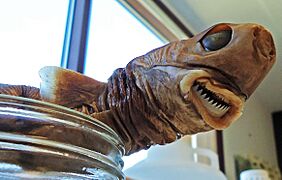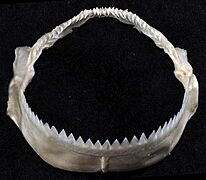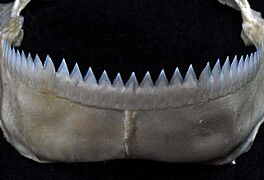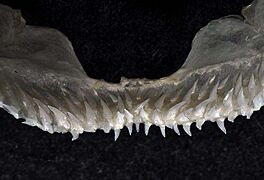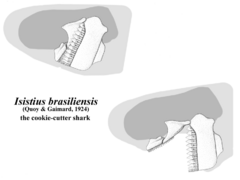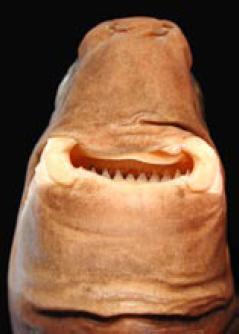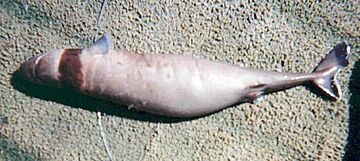Cookiecutter shark facts for kids
Quick facts for kids Cookiecutter shark |
|
|---|---|
 |
|
| Conservation status | |
| Scientific classification | |
 |
|
| Range of the cookiecutter shark |
The cookiecutter shark, also known as the cigar shark or luminous shark, is a small and rarely seen shark. It's famous for its unique way of feeding, which leaves perfect round "cookie-cutter" shaped marks on much larger animals.
Contents
Meet the Cookiecutter Shark
This amazing shark gets its name from the round bite marks it leaves on its prey. Imagine a cookie cutter taking a perfect circle out of dough! That's what this shark does to the skin of large marine animals.
How the Cookiecutter Shark Got Its Name
French scientists Jean René Constant Quoy and Joseph Paul Gaimard first described this shark in the early 1800s. They named it Scymnus brasiliensis because the first one was found near Brazil. Later, an American scientist named Theodore Nicholas Gill gave it the new name Isistius, inspired by Isis, an ancient Egyptian goddess of light. This was because of the shark's glowing body.
For a long time, people didn't know what caused the strange round wounds on whales and other sea creatures. Ancient Samoan legends even talked about fish leaving pieces of their flesh as sacrifices. In 1971, a scientist named Everet Jones finally figured out that the "cigar shark" (as it was then called) was the culprit. Shark expert Stewart Springer then helped popularize the name "cookiecutter shark."
What Does a Cookiecutter Shark Look Like?
The cookiecutter shark has a long, cigar-shaped body. It has a short, rounded snout and large, green eyes that face forward. Behind its eyes are small openings called spiracles.
Its mouth is short and has thick, suction-cup-like lips. The teeth are very different in the upper and lower jaws. The upper teeth are small and pointed. The lower teeth are much larger, wider, and sharp like a knife. They fit together to form a single cutting edge, like a saw.
This shark has two small dorsal fins far back on its body. It doesn't have an anal fin. The tail fin is wide, with the bottom part almost as big as the top. Its skin is covered in tiny, flat scales called dermal denticles.
Colors and Glow
Cookiecutter sharks are usually chocolate brown. They are a bit lighter underneath. A dark "collar" wraps around their gill area.
The most amazing thing about them is their glow! Special light-producing organs called photophores cover almost their entire underside. These organs create a bright green light. The largest cookiecutter sharks found are about 42 cm (17 inches) for males and 56 cm (22 inches) for females.
Where Do Cookiecutter Sharks Live?
Cookiecutter sharks live in all the world's main tropical and warm temperate oceanic basins. They are most common in areas where the surface water is warm, between 18°C and 26°C (64°F and 79°F). You can find them in the Atlantic, Indian, and Pacific Oceans.
Deep-Sea Dwellers
These sharks spend their days in very deep water, sometimes as deep as 3.7 kilometers (2.3 miles). At night, they swim up closer to the surface, usually staying below 85 meters (279 feet). They rarely come right to the surface. This daily up-and-down movement is called a diel vertical migration. They are often found near islands, possibly because there are more large prey animals there.
Cookiecutter Shark Habits
The cookiecutter shark is best known for biting neat, round chunks of flesh from large marine animals. It's like a parasite, but it also eats smaller prey whole. It has a very wide mouth and a strong bite.
This shark is an ambush predator. It doesn't swim fast. Instead, it waits quietly in the water. Its liver is very large and full of oil, which helps it float easily without much effort. Its large tail fin allows it to make a quick burst of speed to catch prey that comes close.
Tooth Recycling
Unlike most sharks that lose teeth one by one, the cookiecutter shark sheds its lower teeth in entire rows! It then swallows these old rows of teeth. This helps the shark recycle the calcium from its teeth, which is a smart way to save resources.
Glowing Lure
The cookiecutter shark has the strongest natural glow of any shark. This green light can even last for hours after the shark is taken out of the water! The glowing organs on its belly help it hide from predators below. This is called counter-illumination. It makes the shark's outline disappear against the faint light coming from the surface.
Interestingly, the dark "collar" around its throat does not glow. Scientists believe this dark area might act as a lure. It could look like a small fish swimming alone, attracting bigger fish to come closer. If this is true, the cookiecutter shark would be unique. It uses light to hide and the absence of light to attract prey!
What Do They Eat?
Almost any medium to large oceanic animal can be a target for the cookiecutter shark. Bite marks have been found on many different creatures. These include whales, dolphins, seals, larger sharks (like great white sharks), stingrays, and many types of bony fishes (like tunas).
The cookiecutter shark also hunts and eats whole squid. These squid can be quite large, sometimes almost as big as the shark itself! They also eat smaller prey like tiny crustaceans.
The bites left by cookiecutter sharks are usually about 5 cm (2 inches) across and 7 cm (2.8 inches) deep. On some spinner dolphins in Hawaii, almost every adult has scars from these sharks.
How They Bite
The cookiecutter shark has a special way of biting. First, it attaches itself to its prey. It uses its suction-cup-like lips to create a tight seal. Then, it bites down with its narrow upper teeth to hold on. Its super-sharp lower teeth slice into the prey. Finally, the shark twists its body to cut out a perfect circular piece of flesh. This is often helped by the prey's own movements as it tries to get away.
Life Cycle
Like other dogfish sharks, the cookiecutter shark gives birth to live young. The baby sharks grow inside the mother, getting food from a yolk sac. Females usually have 6 to 12 pups at a time. Newborn cookiecutter sharks are about 14 to 15 cm (5.5 to 6 inches) long. Males become adults when they are about 36 cm (14 inches) long, and females at about 39 cm (15 inches).
Cookiecutter Sharks and Humans
Cookiecutter sharks usually live far out in the ocean, so people rarely see them. Because of their small size, they are not considered dangerous. However, there have been a few rare reports of them biting humans. In one case, a group of these sharks attacked an underwater photographer. There are also stories from shipwreck survivors who got small, clean, deep bites during the night.
Damage to Submarines and Equipment
In the 1970s and 1980s, cookiecutter sharks caused problems for the U.S. Navy. They bit the rubber parts of submarines, causing damage. At first, the Navy thought it might be an unknown enemy weapon! But they soon found out the cookiecutter shark was the culprit. They fixed the problem by adding strong fiberglass covers to the damaged areas.
This shark has also damaged oceanographic equipment and underwater telecommunications cables.
Conservation Status
Cookiecutter sharks are too small to be valuable for fishing. They are sometimes caught by accident in fishing nets, but not often. Because they live all over the world and there are no major threats to their population, the IUCN lists the cookiecutter shark as a species of "least concern." This means they are not currently at risk of disappearing.
See also
 In Spanish: Tollo cigarro para niños
In Spanish: Tollo cigarro para niños




